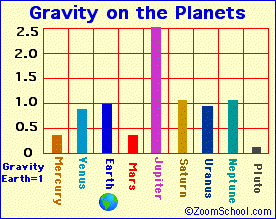So for today's blog update, I've decided to present information about the planets. An easy way to remember the order of the planets (plus Pluto) is the mnemonics: "My Very Excellent Mother Just Sent Us Nine Pizzas."
The solar system is made up of two parts. The inner solar system contains Mercury, Venus, Earth and Mars. These four planets are closest to the Sun. The rocky planets are mostly made up of rock and metal. These planets are very heavy and move slowly. They also do not have rings and very few moons.
Mercury is 36 million miles (57.9 million km)from the sun. This planet has no moons.
Venus is 67.2 million miles (108.2 million km) from the sun. This planet has no moons.
Earth is 93 million miles (149.6 million km) from the sun and has one moon.
Mars is 141.6 million miles (227.9 million km) from the sun and has two moons.
The inner planets are separated from the outer planets by the Asteroid Belt. Asteroids are primordial objects left over from the formation of the Solar System. While some have suggested that they are the remains of a protoplanet that was destroyed in a massive collision long ago, the prevailing view is that asteroids are leftover rocky matter that never successfully coalesced into a planet.
The outer solar system contains Jupiter, Saturn, Uranus, and Neptune. The gas planets are mostly made up of gases (hydrogen and helium). These planets are light for their sizes (just like a big air balloon) and move quickly. They have rings and lots of moons.
Jupiter is 483.6 million miles (778.3 million km) miles from the sun and has 18 named moons plus numerous smaller moons.
Saturn is 886.7 million miles (1,427.0 million km) from the sun and has more than 18 moons.
Uranus is 1,784.0 million miles (2,871.0 million km) from the sun and has 15 moons.
Neptune is 2,794.4 million miles (4,497.1 million km) from the sun and has 2 moons.
The relative size of the planets is shown in the picture below:
The largest planet is Jupiter. It is followed by Saturn, Uranus, Neptune, Earth, Venus, Mars, Mercury, and finally, tiny Pluto (the largest of the dwarf planets). Jupiter is so big that all the other planets could fit inside it.
Generally, the farther from the Sun, the cooler the planet. Differences occur when the greenhouse effect warms a planet (like Venus) surrounded by a thick atmosphere.
The outer, gaseous planets are much less dense than the inner, rocky planets. The Earth is the densest planet. Saturn is the least dense planet; it would float on water.
Jupiter is by far the most massive planet; Saturn trails it. Uranus, Neptune, Earth, Venus, Mars, and Pluto are orders of magnitude less massive.
The planet with the strongest gravitational attraction at its surface is Jupiter. Although Saturn, Uranus, and Neptune are also very massive planets, their gravitational forces are about the same as Earth. This is because the gravitational force a planet exerts upon an object at the planet's surface is proportional to its mass and to the inverse of the planet's radius squared.
A day is the length of time that it takes a planet to rotate on its axis (360°). A day on Earth takes almost 24 hours. The planet with the longest day is Venus; a day on Venus takes 243 Earth days. (A day on Venus is longer than its year; a year on Venus takes only 224.7 Earth days). The planet with the shortest day is Jupiter; a day on Jupiter only takes 9.8 Earth hours! When you observe Jupiter from Earth, you can see some of its features change.
Since each planet has its own mass and gravitational pull, you would weigh a different weight if you were standing on each planet. Mass is a measure of how much matter an object has. Weight is a measure of how strongly gravity pulls on that matter. Thus if you were to travel to other planets, your weight would change because the pull of gravity would be different than it is on earth, but your mass would stay the same because you are still made up of the same amount of matter and the same number of atoms. If you weigh 200 pounds on earth, your weight would be:
--On Mercury 75.6 pounds (34.3 kg)
--On Venus 181.4 pounds (82.3 kg)
--On the Moon 33.2 pounds (15.1 kg)
--On Mars 75.4 pounds (34.2 kg)
--On Jupiter 472.8 pounds (214l5 kg)
--On Saturn 212.8 pounds (96.5 kg)
--On Uranus 177.8 pounds (80.6 kg)
--On
Some of the information included in today's posting came from: http://www.zoomwhales.com/subjects/astronomy/planets/.
















No comments:
Post a Comment